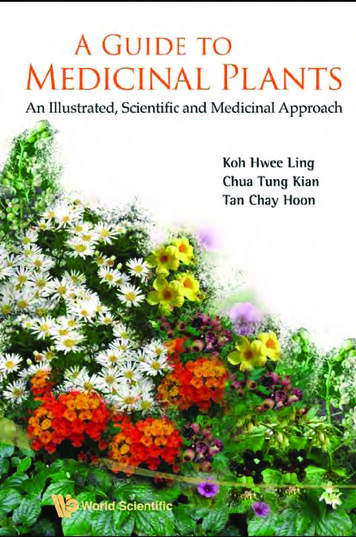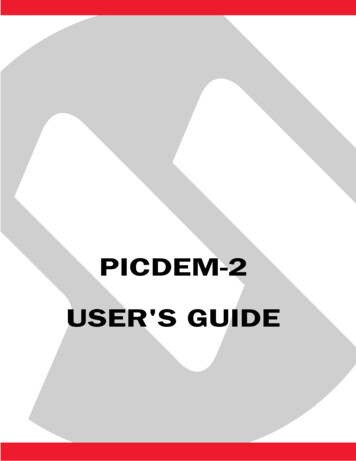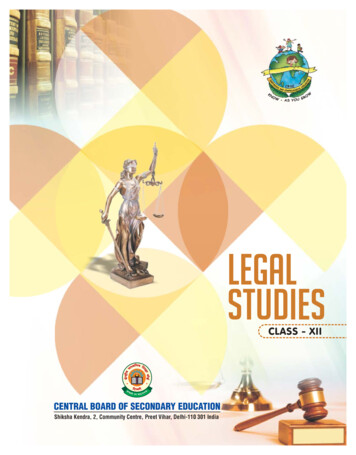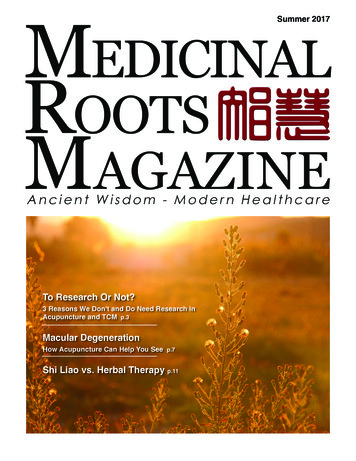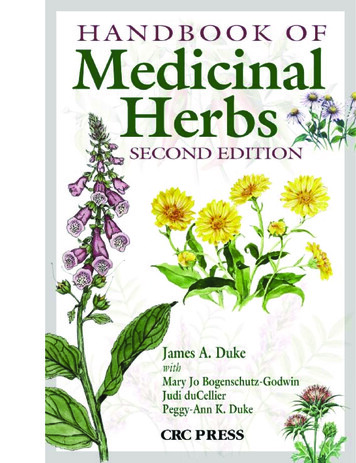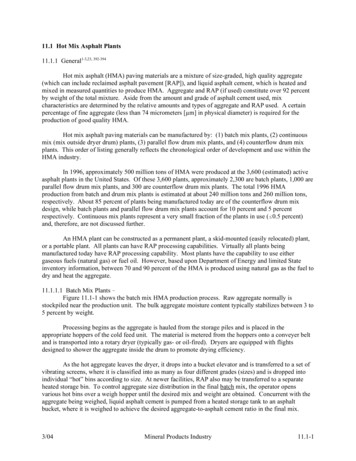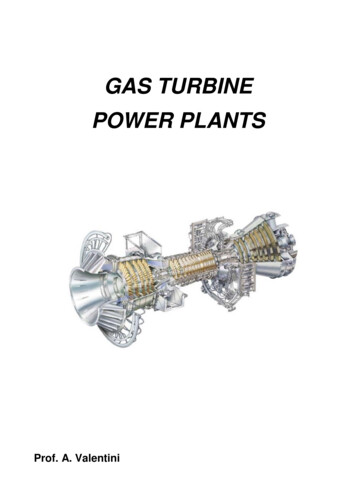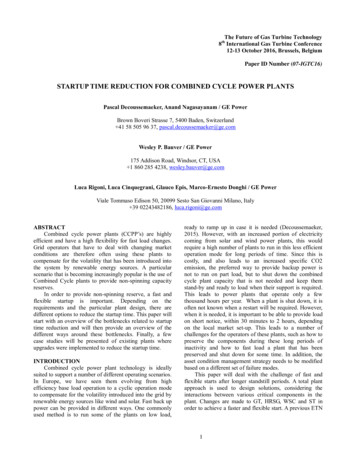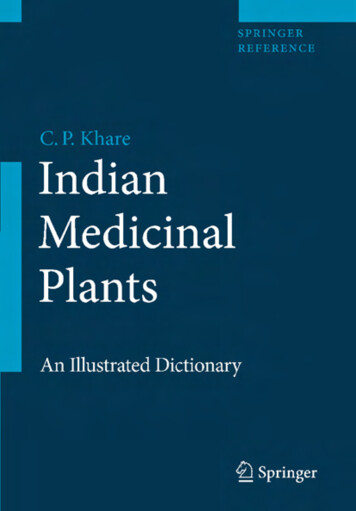
Transcription
Indian Medicinal Plants
C.P. Khare (Ed.)Indian Medicinal PlantsAn Illustrated DictionaryWith Pictures of Crude Herbs123
AuthorC.P. KhareB- / , Janak PuriNew Delhi- Indiachandrma khare@yahoo.comLibrary of Congress Control Number: ISBN: - - - - Springer-Verlag Berlin/Heidelberg Springer Science Business Media, LLC.All rights reserved. This work may not be translated or copied in whole or in part without thewritten permission of the publisher (Springer Science Business Media, LLC., Spring Street,New York, NY , USA), except for brief excerpts in connection with reviews or scholarlyanalysis. Use in connection with any form of information storage and retrieval, electronic adaptation, computer software, or by similar or dissimilar methodology now known or hereafterdeveloped is forbidden. The use in this publication of trade names, trademarks, service marks,and similar terms, even if they are not identified as such, is not to be taken as an expression ofopinion as to whether or not they are subject to proprietary rights.springer.comPrinted on acid-free paperSPIN: —
Dedicated tothe distinguished scientistDr. A. P. J. Adbul Kalamwho revived the glory ofIndian medicinal and aromatic plantsin the Rashtrapati Bhawan.
Guiding FactorsFirst of all, let me acknowledge with gratitude the contribution of the followingreference works which synchronised the synonyms and medicinal properties ofIndian medicinal plants: A Catalogue of Indian Synonyms of the Medicinal Plants of India by MoodeenSheriff ( ). (The first exhaustive compilation of synonyms of Indian medicinal plants in regional languages, besides Latin and English). Indian Medicinal Plants by Lt. Col. K.R. Kirtikar and Major B.D. Basu ( ). Glossary of Indian Medicinal Plants by Col. Sir Ram Nath Chopra et al. (CSIR, ). Useful Plants of India (CSIR, ; based on The Wealth of India series, Vol. I , Vol. XI ). Dictionary of Indian Medicinal Plants by Akhtar Husain et al. (CIMAP, ).Based on this legacy, Indian Medicinal Plants. An Illustrated Dictionary is aimedat bringing out an updated Active Study Dictionary of plant sources of Indianmedicine, as a companion volume of my earlier book Encyclopedia of IndianMedicinal Plants/Indian Herbal Remedies, published by Springer.Ayurvedic synonyms have been selected from the following sources: The Ayurvedic Pharmacopoeia of India (Vol. I to IV). Standard Nomenclature of Ayurvedic Medicinal Plants (CCRAS, ). Medicinal Plants used in Ayurveda (Rashtriya Ayurveda Vidyapeeth/ NationalAcademy of Ayurveda, ). Plants of Sharangadhara Samhita by Prof. K.C. Chunekar and Dr. K. Pondel(National Academy of Ayurveda, ).
VIIIGuiding Factors Plants of Bhava Prakash by Prof. K.C. Chunekar and Dr. N.P. Hota (NationalAcademy of Ayurveda, ). Central Council for Research in Ayurveda and Siddha (CCRAS). Publishedliterature. Dravyagun Vigyaan, Vol. II (Hindi) by Dr. Priyavrata Sharma ( ).Unani synonyms have been selected from the following sources: The National Formulary of Unani Medicine. Central Council for Research in Unani Medicine (CCRUM). Published literature. Unani Dravyagunaadarsh (Hindi) by Daljit Singh (Ayurvedic and Tibbi Academy, Uttar Pradesh, Lucknow, ).Siddha/Tamil synonyms have been selected from the following sources: Formulary of Siddha Medicine. (Indian Medical Practitioners’ CooperativePharmacy and Store Ltd., IMPCOPS, Chennai). The Wealth of India (Vol. II to XI). Dictionary of Indian Medicinal Plants (CIMAP). The Ayurvedic Pharmacopoeia of India (Vol. I to IV). Central Council for Research in Ayurveda and Siddha (CCRAS). Publishedliterature.The medicinal plants shortlisted by the National Academy of Ayurveda andthe department of Indian Systems of Medicine (AYUSH) have been included inthe book.Key applications of medicinal plants are based on the following sources: German Commission E monographs. ESCOP monographs. WHO monographs. Indian Herbal Pharmacopoeia. The Ayurvedic Pharmacopoeia of India (Vol. I to IV) for traditionally recognisedapplications.
Guiding Factors The British Herbal Pharmacopoeia. The British Herbal Compendium. Natural Medicines Comprehensive Database, .For further study, all major findings and leads, including references to research documents and journals, can be reached through the following books (insequence): The Wealth of India First Supplement Series (Vol. I to V). The Wealth of India original series (Vol. II to XI and revised Vol. to ). Compendium of Indian Medicinal Plants (Vol. I to V, CDRI). Potter’s New Cyclopaedia of Botanical Drugs and Preparations ( edn). Natural Medicines Comprehensive Database, . PDR for Herbal Medicines, . The Treatise on Indian Medicinal Plants (Vol. I to VI). Additional sources, as cited at appropriate places.Dosage of crude herbs is based on the recommendations of The AyurvedicPharmacopoeia of India (Vol. I to IV) and Standard Nomenclature of AyurvedicMedicinal Plants (CCRAS).Roman spellings of Ayurvedic synonyms, introduced for the first time byRashtriya Ayurveda Vidyapeeth (National Academy of Ayurveda), New Delhi , have been followed. Asiatic Society’s markings are now obsolete. Thetext has been formatted following the style-manual of The Wealth of India seriesof CSIR.Detailed references of research journals are beyond the purview of this project.The text is based on authentic treatises which are the outcome of scientificscreening and critical evaluation by eminent scholars. As I have already indicated,readers, if they so desire, can always refer back to a particular research papercited in the original source. I did not follow the trend of enumerating researchpapers which were not actually consulted by me. Researchers should consult theDatabase on Medicinal Plants used in Ayurveda series (CCRAS) and Reviews onIndian Medicinal Plants series (ICMR) for detailed bibliography.All Indian common names have been spelled according to their actual pronunciation. The way was shown by the National Academy of Ayurveda byintroducing aa in the spellings. In The Review of Natural Products (Facts andComparisons) edition., Khat, Chaat, Chat, qaad, jaad and Miraa have beenIX
XGuiding Factorsincluded among the common names of Catha edulis, while the common nameof Gymnema sylvestre is spelled as Gurmar instead of Gurmaar. Perhaps theactual pronunciation was not known to the editors. In India, O is pronouncedin a specific ascent, as in Om, that is the reason uu is used instead of oo. Similarly, Sanskrit synonyms end with a, that is why aa is used for facilitating properpronunciation. These changes have been included so that Indian names arepronounced correctly.A few words of gratitude. Dr. V.K. Agarwal Ph. D. (Medicinal Chemistry), whowas the senior editor (chemistry and pharmacology) of The Wealth of India seriesfor years, reviewed the entire text. He remained closely associated with all myprojects and deserves much more than a few formal words of thanks. Sarita Joshi,my research associate, bore the brunt of the workload throughout the difficultphases of the project. For this she also deserves a special mention.Finally, I would like to add that a concerted effort has been made in the bookto rationalise the therapeutic coverage of Indian medicinal plants as part of mycommitment to scientific herbalism.C.P. KhareSociety for New Age HerbalsB- / , Janak Puri, New Delhi-
AAbelmoschus esculentus(Linn.) Moench.Synonym Family Hibiscus esculentus Linn.Malvaceae.Habitat Native to tropical Africa;cultivated throughout India, up to , m.English Gumbo, Lady Finger, Okra.Ayurvedic Bhaandi, Bhindaka,Bhendaa.Unani Baamiyaa.Siddha/Tamil Folk Vendai.Bhindi, Raamturai.Action Immature pods (decoction)—emollient, demulcent anddiuretic (in catarrhal affections,ardor urine, dysuria, dysentery).Seeds—antispasmodic.Fatty fraction of the fresh watery extract of the seeds causes destructionof cancerous cell growth in vitro. Thepods are reported to exhibit antitumour activity. An ethanolic extractof pods was effective against Grampositive bacteria.The ripe fruits contain quercetin,hyperin (hyperoside), hydrolysate ofprecipitated mucilage, proanthocyanidins, D-glucose, D-glucuronic andgalacturonic acids.Fresh flowers contain flavonol glycosides and anthocyanins.Abies pindrow Royle.Synonym A. pindrow Spach.A. webbiana Lindl. var. pindrowBrandis.Pinus pindrow Royle.Family Pinaceae.Habitat Kashmir, HimachalPradesh, Tehri-Garhwal and otherareas of northern India, at altitudesof , – , m.English Pindrow-Fir, Silver-Fir, TheWest-Himalayan Low-Level Fir.Ayurvedic Taalisha (related sp.).Folk Badar, Morinda, Raisalla,Ransla.Action Uses similar to those of A.webbiana.Terpenoids, flavonoids, glycosidesand steroids of the leaf were foundto have mast cell stabilizing action inrats. Terpenoids and flavonoids offered bronchoprotection against histamine challenge in guinea pigs. Theulcer protective action of petroleumether, benzene and chloroform fraction has been attributed to steroidalcontents. Terephthalic acid demethylester (TADE), isolated from the leaf,exhibited protection against inflammation and bronchospasm in guinea pigs.Ethanolic extract of leaves showed significant anxiolytic effects on all theparadigms of anxiety, barbiturate hypnosis potentiation.Pindrolactone, a lanostane-basedtriterpene lactone, isolated from the
2AAbies webbiana Lindl.leaves, showed mild activity againstGram-positive bacteria but exhibited potent antibacterial activity againstGram-negative bacteria E. coli.Abies webbiana Lindl.Synonym A. spectabilis (D. Don)Spach.Pinus webbiana Wall.Family Pinaceae.Habitat The Himalayas fromKashmir to Assam at altitudes of , – , m.English Indian Silver Fir, TheWest-Himalayan High-Level Fir,The East-Himalayan Fir.Ayurvedic Taalisa, Taalisapatra,Taalisha, Patraadhya, Dhaatriparni,Dhaatripatra.Unani Taalisapattar.Siddha/Tamil Taalispatri.Folk Badar, Chilrow, Morinda,Raisalla, Taalispatra. (Tallispatra,Taalispatri and Talespattre arealso equated with the leaves ofCinnamomum tamala Nees.)Action Expectorant, bronchial sedative, decongestant, anticatarrhal,antiseptic, carminative.Key application Fir (Abies albaMiller) needle oil—in catarrhal illness of upper and lower respiratorytract (internally and externally);externally in rheumatic and neuralgic pains. Contraindicated inbronchial asthma and whoopingcough. (German Commission E.)A biflavonoid, abiesin, n-triacontanol, beta-sitosterol and betuloside arepresent in the leaves.The essential oil from leaves contains alpha-pinene, l-limonene, deltacarene, dipentene, l-bornyl acetate andl-cardinene as major constituents.Dosage Needles— – g powder.(API Vol. IV.)Abroma augusta Jacq.Synonym Ambroma augustaLinn. f.Family Sterculiaceae.Habitat Throughout the hotter andmoister parts of India, from Punjaband Uttar Pradesh, eastwardsto Arunachal Pradesh, Assam,Meghalaya and Tripura, ascendingto , m, southwards in PeninsularIndia.English Perennial Indian Hemp,Devil’s Cotton.Ayurvedic Pishaacha Kaarpaasa,Pivari.Unani Ulat-kambal.Siddha/Tamil Folk Sivapputtuti.Kumal, Sanukapaasi.Action Rootbark—emmenagogue (used for dysmenorrhoea,amenorrhoea), abortifacient, galactotrophic.The root contains abromine (betaine), friedelin, abromasterol, abromasterol A, choline, beta-sitosterol,stigmasterol and octacosanol. Leaves,reported to be useful in treating uterine
Abutilon indicum Linn. Sweet.disorders, contain taraxerol, its acetateand lupeol.Dosage Leaf juice— – ml.Rootbark powder— – g. (CCRAS.)Abrus precatorius Linn.Family Papilionaceae; Fabaceae.Habitat Throughout the country,ascending to an altitude of about , m in the outer Himalayas.English Indian Wild Liquorice,Jequirity, Crab’s Eye, PrecatoryBean.Ayurvedic Gunjaa, Gunjaka,Chirihintikaa, Raktikaa, Chirmiti, Kakanti, Kabjaka, Tiktikaa,Kaakananti, Kaakchinchi. (Not tobe used as a substitute for liquorice.)Unani Ghunghchi, Ghamchi.Siddha/Tamil Folk Kunri.Chirmiti, Ratti.Action Uterine stimulant, abortifacient, toxic. Seeds—teratogenic. Apaste of seeds is applied on vitiligopatches.Along with other therapeutic applications, The Ayurvedic Pharmacopoeiaof India has indicated the use of seedsin baldness.Seeds contain abrin, a toxalbumin,indole derivatives, anthocyanins, sterols, terpenes. Abrin causes agglutination of erythrocytes, haemolysis andenlargement of lymph glands. A nontoxic dose of abrin ( . mcg/kg bodyweight), isolated from the seeds of redvar., exhibited a noticeable increase inantibody-forming cells, bone marrowcellularity and alpha-esterase-positivebone marrow cells.Oral administration of agglutinins,isolated from the seeds, is useful in thetreatment of hepatitis and AIDS.The seed extract exhibited antischistosomal activity in male hamsters.The methanolic extract of seeds inhibited the motility of human spermatozoa.The roots contain precol, abrol, glycyrrhizin ( . %) and alkaloids—abrasine and precasine. The roots also contain triterpenoids—abruslactone A,methyl abrusgenate and abrusgenicacid.Alkaloids/bases present in the rootsare also present in leaves and stems.A. fruticulosus Wall. Ex Wight andArn. synonym A. pulchellus Wall., A.laevigatus E. May. (Shveta Gunjaa) isalso used for the same medicinal purposes as A. precatorius.Dosage Detoxified seed— – gpowder. Root powder— – g. (APIVols. I, II.)Abutilon indicum Linn. Sweet.Synonym Family A. indicum G. Don.Malvaceae.Habitat Throughout the hotterparts of India. Found as a weed inthe sub-Himalayan tract and otherhills up to , m.English Country Mallow, FloweringMaples, Chinese Bell-flowers.Ayurvedic Atibalaa, Kankatikaa,Rishyaproktaa.3A
4AAcacia arabica Willd. var. indica Benth.Unani Kanghi, Musht-ul-Ghaul,Darkht-e-Shaan.Siddha/Tamil Folk Thutthi.Kanghi, Kakahi, Kakahiyaa.Action Dried, whole
Guiding Factors IX TheBritishHerbalPharmacopoeia. TheBritishHerbalCompendium. NaturalMedicinesComprehensiveDatabase, . For furtherstudy, all major .
